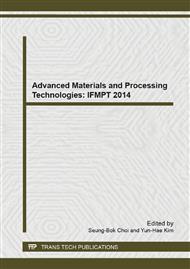p.279
p.285
p.289
p.293
p.297
p.301
p.306
p.312
p.316
Study on the Y3+-Trpptophan-Curcumin-SDBS System by Spectrophotometry and its Analytical Application
Abstract:
Curcumin (C21H20O6, CU) is a natural antioxidant, which is considered to be a very useful compound in health matters, and is employed in the treatment of cardiovascular and arthritic illnesses. It is found that the fluorescence intensity of Y3+-trpptophan (Trp) can be greatly quenched by curcumin in the presence of sodium dodecyl benzene sulfonate (SDBS). Under optimum conditions, the quenched intensity of fluorescence is in proportion to the concentration of curcumin in the range of 73.68-442.1, 0.074-5.3μg·mL-1. The detection limit (S/N=3) is 0.0185μg·mL-1. The actual samples are satisfactorily determined.
Info:
Periodical:
Pages:
297-300
Citation:
Online since:
February 2014
Authors:
Keywords:
Price:
Сopyright:
© 2014 Trans Tech Publications Ltd. All Rights Reserved
Share:
Citation:


